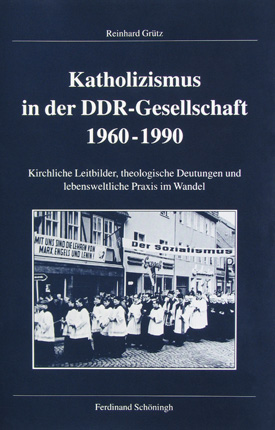Grütz, Reinhard: Katholizismus in der DDR-Gesellschaft 1960–1990. Kirchliche Leitbilder, theologische Deutungen und lebensweltliche Praxis im Wandel. Paderborn [u. a.] 2004

Scholarship on East German Catholicism has previously been dominated by political science or strictly church-historical approaches. Reinhard Grütz, by contrast, orients his study along cultural-historical perspectives. Grütz’s book focuses on patterns of interpretation, mental images, and symbols that were widespread in East German Catholicism between 1960 and 1990; change and continuity in these areas are at the center of his work.
Grütz reconstructs »internal views« of East German Catholicism, showing how its reservoir of norms and symbols underwent fundamental changes since the 1960s. As a result of these changes, a diverse (if limited) spectrum of inner-church positions emerged, as well as a growing range of lifestyles practiced by – and considered acceptable for – Catholics. These developments were paralleled by social and educational advances on the part of Catholics. By the GDR’s final years, the traditional educational deficit vis a vis non-Catholics no longer applied to younger Catholics. The disproportionately large numbers of East German Catholics who served in political offices and committees after 1990 was one expression of these changes.
In the first section of his study, Grütz discusses fundamental concepts and themes: the role of religion in the GDR, the relationship between GDR society and modernization, current trends in research on Catholicism, and the specifically theological concept of reception. The second section offers a framework for conceptualizing the arguments over the Second VaticanCouncil that took place within GDR Catholicism. The author’s aim is to illuminate the »hidden history of conflict« associated with the reception of the Council. Also in this section, Grütz analyzes those themes and discourses central to East German Catholicism: marriage and family, parish and diaspora, and the image of the priest. These constituted the »life horizon« of Catholics in the GDR and a specifically Catholic culture formed within or around them.
Grütz thereby paints a colorful picture of Catholic life in the GDR during the last three decades before the peaceful revolution of 1989.
To order our publications, please, contact your local bookshop or the publishing house Schöningh in Paderborn.
